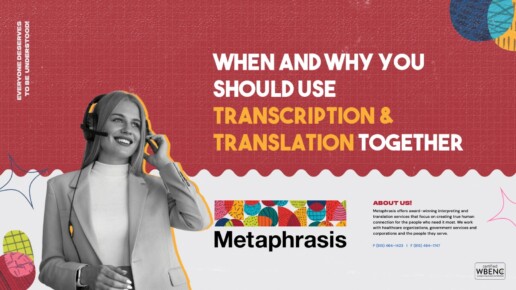When and Why You Should Use Transcription and Translation Together
Introduction
In a world that thrives on communication, language barriers can pose significant challenges. Businesses, content creators, legal professionals, and researchers often need to make information accessible to a diverse, multilingual audience. This is where transcription and translation come into play.
Transcription involves converting spoken words into written text, while translation takes that text and converts it into another language. When used together, these services ensure that audio and video content can be understood globally. Companies like Metaphrasis specialize in these services, helping organizations bridge communication gaps effectively.
But when should you use transcription and translation together? Why is this combination so powerful? Let’s explore the benefits and practical applications.
What is Transcription?
Definition and Purpose
Transcription is the process of converting spoken words from an audio or video source into written text. It is widely used in industries like journalism, healthcare, business, education, and entertainment to document conversations, interviews, and meetings.
Types of Transcription
- Verbatim Transcription – Captures everything, including filler words (um, uh), background noises, and pauses.
- Intelligent Verbatim – Removes unnecessary fillers and focuses on the main message.
- Edited Transcription – Improves readability by restructuring sentences and correcting grammar.
Having a transcript is beneficial for accessibility, content repurposing, and legal documentation. But in a multilingual world, transcription alone is not enough. This is where translation becomes essential.
What is Translation?
Definition and Purpose
Translation is the process of converting written text from one language to another while maintaining accuracy, tone, and meaning. It ensures that content can be understood by people who speak different languages.
- Literal Translation – Word-for-word translation, useful for technical documents.
- Dynamic Translation – Focuses on meaning rather than exact wording.
- Localization – Adapts the content to suit cultural nuances and preferences.
A transcript in one language is useful, but to reach a global audience, it needs to be translated. That’s where transcription and translation work together seamlessly.
When to Use Transcription and Translation Together
There are many situations where both transcription and translation are necessary. Here are some common scenarios:
- Business and Corporate Communication
- International companies conduct meetings with employees and clients from different countries.
- Transcribing and translating meeting minutes helps everyone stay informed.
- Legal contracts and compliance documents often require transcription and translation for clarity.
- Media and Entertainment
- Movies, TV shows, and online content need subtitles in multiple languages.
- Podcasts and YouTube videos can reach a wider audience when transcribed and translated.
- Dubbing and voice-over require accurate scripts that are both transcribed and translated.
- Academic and Research Applications
- Researchers often conduct interviews in different languages; transcribing and translating them ensures wider accessibility.
- Universities and e-learning platforms use transcription and translation for online courses to cater to global students.
- Legal and Healthcare Sectors
- Court proceedings, depositions, and witness statements often need both transcription and translation for accurate documentation.
- Medical records and patient consultations require transcription and translation to ensure proper care and compliance.
- Digital Marketing and Content Creation
- Businesses can expand their reach by localizing their content.
- Transcribing and translating blogs, webinars, and social media content enhances engagement.
- SEO benefits: Multilingual content improves search engine rankings and attracts a global audience.
Why Use Transcription and Translation Together?
Now that we know when to use these services, let’s explore why combining them is so beneficial.
- Expanding Global Reach
By transcribing and translating content, businesses and content creators can connect with a global audience. This is especially important for companies looking to enter new markets.
- Accessibility and Inclusivity
Transcripts help individuals with hearing impairments, while translations ensure that non-native speakers can understand the content. This makes information more inclusive and accessible.
- Improved Accuracy and Clarity
When an audio file is transcribed before being translated, the translator has a clear and structured text to work with. This reduces the chances of misinterpretation and ensures accuracy.
- Better Content Repurposing
Transcribed and translated content can be repurposed into blogs, articles, subtitles, and social media posts. This extends the lifespan of content and increases its value.
- Compliance and Legal Requirements
Certain industries, such as law and healthcare, require accurate documentation in multiple languages for compliance purposes. Transcription and translation together ensure that legal and medical records are correctly recorded and understood.
How Metaphrasis Can Help
Metaphrasis specializes in professional translation services, ensuring high accuracy and cultural sensitivity. With expertise in multiple industries, they help businesses, media companies, and professionals communicate effectively across languages.
What Sets Metaphrasis Apart?
- Experienced linguists and transcribers ensuring top-quality work.
- Use of advanced AI tools combined with human expertise for efficiency and accuracy.
- Industry-specific knowledge, catering to legal, healthcare, corporate, and entertainment sectors.
Conclusion
Transcription and translation are powerful tools that, when used together, break down language barriers, improve accessibility, and expand global reach. Whether you’re a business, educator, researcher, or content creator, leveraging both services can help you communicate more effectively.
Companies like Metaphrasis provide expert transcription and translation solutions, ensuring accuracy, clarity, and cultural relevance. So, if you’re looking to enhance your multilingual communication, consider using transcription and translation together—it’s a game-changer.

